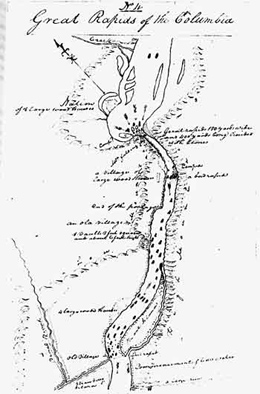In July 1851, Francis A. Chenoweth (1819-1899), who moved west from Wisconsin in 1849 and settled near present day Bonneville Dam on the north side of the Columbia River, begins operating what can be described as the first railroad in the Northwest. Variously estimated at two to four miles long, it is a wood-tracked portage railroad, established to carry freight and passengers around the Cascades rapids in the Columbia River -- downstream from present-day Stevenson, Washington, and upstream from Bonneville Dam. (Decades later the erection of the dam will bury the rapids under water.)
The Columbia River rapids were so swift and treacherous in that area that riverboats could not negotiate them and had to load and unload people and goods at either end of the rapids. Chenoweth’s railroad carried them from one boat to the other to continue the trip.
His railroad was a crude wooden flat car pulled by a mule over fixed wooden rails mounted on a bed of planks.
A partner with Chenoweth early on was J. A. Bush, who had built a hotel in the area. In 1853, Chenoweth, who is also listed by various sources as F. S. Chenoweth, Justin Chenoweth, and Hardin Chenoweth, sold his share of the business to brothers Daniel and Putnam Bradford.
Steel rails and steam power would follow in 1863 when a tiny, steam-powered locomotive named the Ann went into service on the Bradford Brothers’ line, which had been rebuilt and extended to six miles. The Ann was a duplicate of the Oregon Pony, which by then was operating on the south shore and is still on display at Marine Park in Cascade Locks, Oregon. As Theodore Winthrop and John Harvey Williams have written, “out of the feeble runway and Chenoweth's scow grew the great transportation system of the Columbia."

